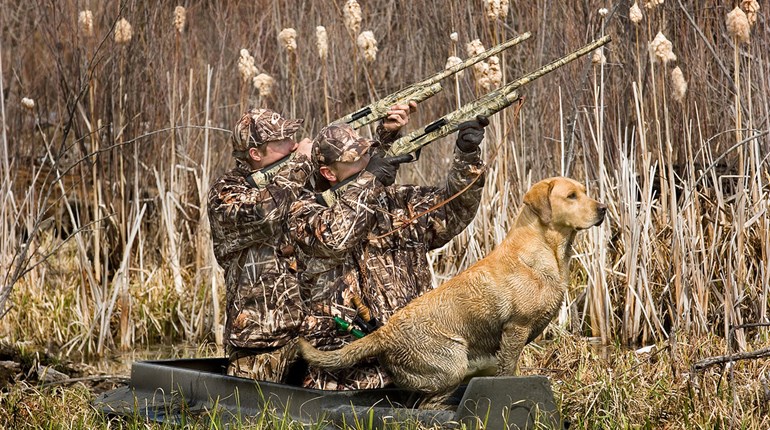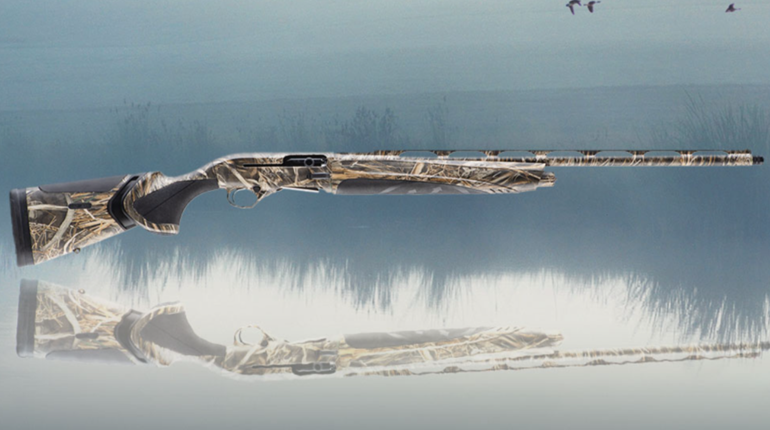Drought. Water shortages. Forest fires. EHD. CWD. Intensive agriculture. Ethanol corn fields. Ever increasing human population. It’s been rough the past several years, leading to a decline in mule deer, sage grouse, pheasants, quail and even the usually hearty whitetail.So hunt ducks and geese.
Duck and goose populations are exploding. Snow, blue and Ross’ geese are dangerously overpopulated, thanks to new forage on their wintering grounds. Canada geese have bred to pest levels since adapting to giant reservoirs, urban parks and grain fields. But this year there’s a bonus. According to the U.S. Fish & Wildlife Service’s 2014 report “Trends in Duck Breeding Populations,” our summer breeding duck population stood at a record-high 49.2 million birds. That’s up 8 percent from last year’s 45.6 million breeding ducks. If each duck contributes just one duckling to the fall flight … we could be covered up in quackers. We’re facing a potential record fall flight. Put another way, don’t miss this one!
For the next hundred years, waterfowlers will refer to 2014 as the Good Old Days, the Glory Years, the Golden Peak of Waterfowling. Where were you, Grandpa? Did you see it? Did you hunt those swarms of ducks and geese that blotted out the sun?
Over the decades we hunters have poured millions of dollars and man-hours into saving, restoring and improving waterfowl habitat. Yes, we still have big obligations to fight for other wildlife and wild places, but we also have personal and spiritual obligations to enjoy what is abundant outdoors. We’ve earned our chance to reap the rewards of waterfowl restoration. Let’s not miss it.
Flurry of Feathers and Fun
“Behind us. Coming in low. Everybody down,” my buddy Scott Grange commanded. Four of us dived into camouflaged Final Approach layout blinds and closed the lids. We were surrounded by several dozen Canada goose and mallard decoys doing their best impression of real birds gorging in the barley stubble.
“Ka-honk, kahonk-a-honk-a-honk. Ka-honk, onk-onk.” We were playing their song, and they sang back, their haunting cries filtering through golden haze worthy of the finest artist’s canvas. It was the kind of scene that justifies arising at 5 a.m.
“Swinging to the south. Turning into the wind.” Scott was keeping us apprised so we weren’t tempted to stick our faces up to look. “Here they come, gliding left to right. I’ll call the shot. Wings cupped …”
If Scott said anything after that, it was lost to wind roaring over pinions, to the promising whoosh-whoosh-whoosh of cupped wings braking heavy birds just before landing …
“Take ’em!” We heard that welcomed shout. Four grown men, eager as teenagers, sat up in the heart of an American tradition as old as hunting itself, rose into the panicked melee of honking, flapping, backpedaling birds that were about to embark on their last flight—to the dinner table. Boom, ba-boom, boom-boom. Thump, thudump, bump, thump. The 12-gauges bucked. Geese crashed to ground—four, eight, 12 of them.
“Twelve?” someone asked as Labs and men piled bird after bird beside the blinds. “We each got three geese? Unbelievable. These are Canada geese, boys. Big, fat, juicy Canada geese! Good shootin’, boys. Good shootin’!”
“And you know the really crazy thing?” Scott chimed in, propping up his last goose, proper like, to act as another decoy among our enticing spread. “This isn’t even half our limit. Can you believe it? A 10-goose limit?”
It was unbelievable, especially for those of us who’d struggled through times and places in the late 20th century with a Canada goose limit of one—just one bird a day. Clearly, conservationists had done something right, and we were celebrating it.
 Places to Hunt
Places to Hunt
Because waterfowl are migratory, predatory of agricultural crops and versatile in their use of wet and dry habitats, finding places to hunt them is relatively easy. Thousands of small to huge swamps, marshes, lakes, reservoirs and saltwater bays are often wide open to public hunting. State and federal wetlands on the northern Plains are open, too, first-come, first-served.
Small ponds on private property often can be accessed just by asking, especially if the birds on them are raiding nearby crops. Hunters willing to work from ground blinds in fields are often welcomed by farmers less than eager to watch a flock of 10,000 geese or mallards descend on wheat, rice, corn or even alfalfa. Because flocks shift and move day to day, farmlands are less likely to be leased for waterfowling than quail or deer hunting. Considerable scouting is required, but a dedicated hunter with wheels and a binocular can pinpoint hotspots, contact landowners and gain permission to set up the next morning or evening for a fast and furious field shoot.
Waterfowlers often usually lease ponds, timbered bottomlands or grain fields on which they manage water to attract ducks. Often they build semi-permanent blinds. That’s another great option. So is joining a waterfowl club, some of which are brand new, others more than a century old.
Canada is a wonderful option, especially in the early season when the bulk of North American waterfowl are up there, pigging out on windrows of wheat and barley and making nuisances of themselves. Outfitters offer fully guided hunts that practically guarantee birds. Guides scout daily and do all the hard work like getting permission and erecting blinds. But it’s quite possible for Americans to drive up, knock on farm doors and get permission to set up in fields and sloughs. A dozen or two decoys are often sufficient to convince gullible birds to pay a close visit. Waders are usually all you need to stay dry in most potholes.
Duck!
“That’s the third flock pouring in. Map says there’s a pothole back there, and the plat map says this guy owns it,” John noted as he pointed to a name on the map. Phil paged the local phone book. We were glassing from the truck on a public road in rural North Dakota.“Here it is.” Phil dialed the number. Five minutes later we had permission to go. When we humped over the wheat field ridge, a classic glacial pothole spread before us, golden cattails waving in the wind, a bit of chop on the gray water and a lot of splash as at least 200 mixed mallards, gadwalls, shovelers, green-winged teal and pintails blasted off, silver streamers trailing.
“They’ll be back soon. Let’s get those decoys out.” We waded cautiously through the deepening waters and spread 30 decoys in a keyhole that opened toward clear water in the middle, but offered a cozy retreat out of the wind with a dense cattail fringe in which we could crouch. John was giving the layout his usual compulsive tweak when Phil announced what we wanted to hear: “Here comes the first bunch.”
The slough lay silent as the flock made its first, high pass, wings rhythmically going swish-wish-wish-wish. When they were showing all butts John and I both launched highballs, letting the birds know they were passing a safe haven. Quaaaaack, quaaack, quaaack, quaack quack-quack-quack. “Comin’ back,” John said, calmly. I slowly ducked my chin until I could just see them at the edge of my cap brim. “Dropping fast. I think they’re going to be in range on this pass.”
The flock, about a dozen mallards with a trailing trio of what looked to be gadwalls, came with the wind, planing steeply over the far side of the slough before banking sharply and setting up into the wind, slowing as they eyed the decoys. And then, flaps down, they were committing. They knew this hole, a safe haven. We were probably the first hunters in it all season, maybe for years. Three drakes led, standing on their tails, wings cupped, orange feet dangling, then flaring. “Take ’em, boys,” John calmly said, and we did.

I should have picked out a drake toward the back. I knew that and so did Phil, but neither of us could tear eyes off that closest drake, orange feet braking, his rusty breast glowing, green head an iridescent contrast to that garish yellow bill. Ba-dam: Two shots fired like one. I switched to a backpedaling drake farther back in the flock, but before I could shoot, it tumbled to John’s shot. I was catching up to a third when Phil collected it.
“Sweet,” Phil said.
“Yeah, this is going to be perfect. But let’s spread out and divide the field into quadrants. I don’t think each bird needs to get shot twice.”
For the next two hours we indulged in what this old Dakota farm boy considers a perfect duck hunt: open spaces, no competition, not even a power pole to indicate the presence of modern man on a rolling landscape sculpted by ice more than 10,000 years earlier. Here was an American original, a prairie pothole of the type that cradles millions of ducks and geese, the vast bulk of the webbed fowl that cross this continent from the Arctic to the Gulf, from Atlantic to Pacific: mallards, redheads, canvasbacks, scaup, wigeon, pintails, teal and more. And we stood beneath them, stood listening to the wind rattling the cattails, to muskrats gnawing, to sharptailed grouse feeding on the hill, to distant flocks of snow geese yipping their enthusiasm for the grain feast spread beneath them. We listened as cautious pintails whistled from rifle range and refused to come down, as teal ripped past, barely off the water. We listened as big mallards splashed among the decoys, white bellies to the sky, orange legs kicking.
And to think this year promises to be even better …

































